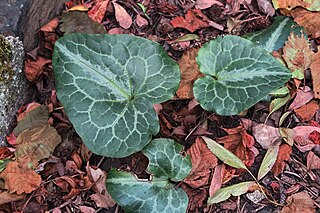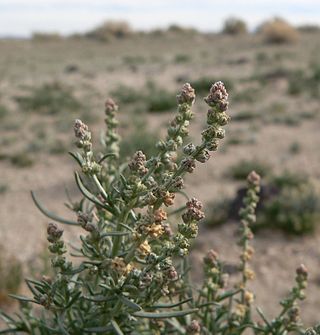
In botany, a fruit is the seed-bearing structure in flowering plants that is formed from the ovary after flowering.

Ixerba brexioides, the sole species in the genus Ixerba, is a bushy tree with thick, narrow, serrated, dark green leaves and panicles of white flowers with a green heart. The fruit is a green capsule that splits open to reveal the black seeds partly covered with a fleshy scarlet aril against the white inside of the fruit. Ixerba is an endemic of the northern half of the North Island of New Zealand. Common names used in New Zealand are tawari for the tree and whakou when in flower. It is assigned to the family Strasburgeriaceae.
Illicium ternstroemioides is a species of tree in the family Schisandraceae, or alternately, the Illiciaceae. It is native to northern Vietnam and Hainan Island in China.

Fruit anatomy is the plant anatomy of the internal structure of fruit. Fruits are the mature ovary or ovaries of one or more flowers. They are found in three main anatomical categories: aggregate fruits, multiple fruits, and simple fruits.

Lepidium flavum is a species of flowering plant in the mustard family known by the common name yellow pepperweed. It is native to California, Nevada, and Baja California, where it grows in the Sonoran and Mojave Deserts. The species epithet flavum is Latin for yellow and indicates its flower colour.

Asarum hartwegii is a species of wild ginger known by the common name Hartweg's wild ginger.

Lythrum portula is a species of flowering plant in the loosestrife family known by the common names water-purslane and spatulaleaf loosestrife. It is native to Europe, and it is found in parts of western North America as an introduced species. It often grows in moist habitat, such as marshes. This is a prostrate annual herb producing a hairless, reddish stem up to 25 centimeters long which lies along the ground and roots where its nodes come in contact with wet earth. The slightly fleshy, spoon-shaped leaves are about a centimeter long and greenish to reddish in color. Solitary flowers occur in leaf axils. Flowers often have white or pink petals about a millimeter long, but some lack petals. The fruit is a spherical capsule containing minute seeds.
Nemophila breviflora is a species of flowering plant in the borage family known by the common names basin nemophila, Great Basin nemophila, and Great Basin baby-blue-eyes. It is native to southwestern Canada and the northwestern United States, where it generally grows in wooded and forested areas in thickets and moist streambanks.

Oligomeris linifolia is a species of flowering plant in the small family Resedaceae known by the common name lineleaf whitepuff. It is native to parts of the Middle East and the Indian subcontinent, as well as southern Europe and North Africa, and the southwestern United States and northern Mexico. It grows in many types of habitat, including disturbed areas and saline soils, in deserts, plains, coastline, and other places. It is a fleshy annual plant, producing several erect, ribbed stems 35 to 45 centimeters in maximum height.

Pityopus is a monotypic genus of flowering plants in the family Ericaceae containing the single species Pityopus californicus, which is known by the common name pinefoot.

Portulaca halimoides is a species of purslane known by the common name silkcotton purslane. It is native to the deserts of the southwestern United States and northern Mexico, as well as parts of Central and South America. It is a fleshy annual herb producing a branching stem spreading to a maximum length around 25 centimeters. It is often pink or red in color and there are strands of woolly hairlike trichomes at nodes along the stem and within the inflorescence. The thick, cylindrical, blunt-tipped leaves are up to 2 centimeters in length and green to red in color. Flowers occur in clusters of up to 10 at the tips of the stem branches. Each is a few millimeters wide with yellow petals which are sometimes hidden under the two fused, fleshy red sepals. The fruit is a tiny capsule which contains several seeds. The grainlike seeds may be black, grayish, or silvery in color.

Micranthes bryophora is a species of flowering plant known by the common name bud saxifrage. It is native to the western United States, where its two varieties are geographically separated. The more common var. bryophora is endemic to the mountains of California, and the rare var. tobiasiae is known only from the Payette National Forest of western Idaho.

Spergularia atrosperma is a species of flowering plant in the family Caryophyllaceae known by the common name blackseed sandspurry. It is native to California and Nevada, where it grows in muddy and sandy habitat, often in moist alkaline substrates. It is a small annual herb producing a slender stem up to 15 centimeters long. It is lined with fleshy linear leaves. The inflorescence bears small flowers with five pointed sepals and five oval white or pink petals. The fruit is a capsule containing shiny, sometimes iridescent, black seeds.

Spergularia canadensis is a species of flowering plant in the family Caryophyllaceae, known by the common name Canadian sandspurry. It is native to North America, where it is known from mainly coastal habitat. It is found along the coastline of Canada and northern parts of the United States, from Alaska to northern California on the West Coast, and as far south as New York on the East Coast.

Spergularia macrotheca is a species of flowering plant in the family Caryophyllaceae known by the common name sticky sandspurry. It is native to western North America from British Columbia to Baja California, where it grows in many types of moist coastal and inland habitat, often in alkaline and saline substrates. It may be found in marshes, alkali flats, beaches, meadows, seeps, and vernal pools. It is a perennial herb producing a narrow stem up to 40 centimeters long with a woody, thickened base and taproot. They may grow erect or prostrate across the ground. It is covered in sticky glandular hairs, especially in the inflorescence. The stems are lined with fleshy linear leaves, sometimes tipped with spines. The leaves are accompanied by triangular stipules up to a centimeter long each. Flowers occur in clusters at the end of the stem as well as in leaf axils. The small flowers have five pointed sepals and five oval white to lavender-pink petals. The fruit is a capsule containing tiny reddish brown, winged seeds.

Streptanthus vernalis is a rare species of flowering plant in the mustard family known by the common name early jewelflower. It was first observed in the 1970s but not actually described to science until 2005. It is endemic to Lake County, California, where it is known from a single occurrence at Three Peaks near the Napa County line. It is apparently limited to serpentine outcrops in forested and chaparral habitat. Genetic analysis indicates that the species is distinct from other Streptanthus and is most closely related to Streptanthus morrisonii, which it resembles. It is a hairless annual herb producing an erect branching or unbranched stem 2 to 20 centimeters tall. The ephemeral basal leaves have thick, fleshy leaves which are green and unmottled on top and purple on the undersides. Leaves higher on the stem are linear to lance-shaped and lack petioles. Flowers occur at intervals along the upper stem. Each flower has an urn-shaped calyx of sepals which is solid green with no purple or yellowish tinge. The petals emerging from the tip are white without darker veining. The fruit is a flattened straight silique 3 to 5 centimeters long containing orange seeds.

Polygala lewtonii is a rare species of flowering plant in the milkwort family known by the common name Lewton's polygala, or Lewton's milkwort. It is endemic to Florida in the United States, where it is limited to the central ridge of the peninsula. There are about 49 occurrences of the plant remaining. Most occurrences contain very few plants. The species is threatened by the loss and degradation of its habitat. This is a federally listed endangered species of the United States.

Plantago cordata is a species of flowering plant in the plantain family known by the common name heartleaf plantain. It is native to eastern North America, where it is distributed throughout eastern Canada and the eastern United States. Though it has a wide distribution, it is very localized, and populations have declined almost everywhere.

Thonningia is a monotypic genus of flowering plants in the family Balanophoraceae containing the single species Thonningia sanguinea. It is distributed throughout much of southern and western Africa, particularly the tropical regions. Common names for the plant include ground pineapple. A familiar plant to humans, it has an extremely long list of common names in many African languages. Many names are inspired by the resemblance of the plant's inflorescence to a pineapple or palm tree. Some of the names can be translated as pineapple of the bush, duiker's kolanut, and crown of the ground.

Callisia repens, also known as creeping inchplant or turtle vine, is a succulent creeping plant from the family Commelinaceae. This species comes from Central and South America.


















